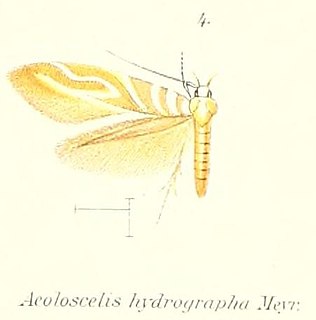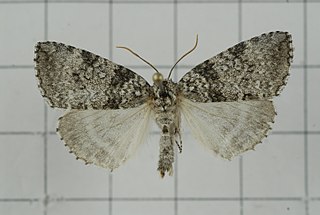Related Research Articles
The Cosmopterigidae are a family of insects in the order Lepidoptera. These are small moths with narrow wings whose tiny larvae feed internally on the leaves, seeds, stems, etc. of their host plants. About 1500 species are described. The taxonomic family is most diverse in the Australian and Pacific region with about 780 species.

Anodonta is a genus of freshwater mussels in the family Unionidae, the river mussels.
The hooded whistler or Guadalcanal hooded whistler is a species of bird in the family Pachycephalidae. It is found on Guadalcanal in the Solomon Islands. Its natural habitat is subtropical or tropical moist montane forest. Prior to 2014, the Bougainville whistler was considered conspecific with the Hooded whistler.
Harmogenanina implicata is a species of air-breathing land snail or semislug, terrestrial pulmonate gastropod mollusk in the family Helicarionidae.

Eurois occulta, the great brocade or great gray dart, is a moth of the family Noctuidae. It is found in northern and central Europe, North Asia and central Asia to the Pacific Ocean and Japan. Also the northern parts of North America. In addition, it is found in Greenland and Iceland. In the south in northern Spain and on the Balkan peninsula.
Schistura implicata is a species of ray-finned fish in the stone loach genus Schistura. It occurs in streams with gravel or stony beds and a moderate to fast current in north eastern Laos and probably also in central Vietnam.
Oxathres is a genus of beetles in the family Cerambycidae, containing the following species:

Phtheochroa implicata, the plain conch, is a species of moth of the family Tortricidae. It is found in China, Iran, Japan, Mongolia, Russia and most of Europe. It has also been recorded from North America. The habitat consists of damp areas and woodland edges.

Isorrhoa is a genus of moths in the family Cosmopterigidae.
Isorrhoa ancistrota is a moth in the family Cosmopterigidae. It was described by Turner in 1923. It is found in Australia, where it has been recorded from Queensland.
Isorrhoa antimetra is a moth in the family Cosmopterigidae. It was described by Edward Meyrick in 1913. It is found in India.
Isorrhoa aphrosema is a moth in the family Cosmopterigidae. It was described by Edward Meyrick in 1897. It is found in Australia, where it has been recorded from Queensland.
Isorrhoa loxoschema is a moth in the family Cosmopterigidae. It was described by Turner in 1923. It is found in Australia.

Isorrhoa triloxias is a moth in the family Cosmopterigidae. It was described by Edward Meyrick in 1907. It is found in Sri Lanka.
Isorrhoa atmozona is a moth in the family Cosmopterigidae. It was described by Turner in 1917. It is found in Australia.
Oxathres implicata is a species of beetle in the family Cerambycidae. It was described by Melzer in 1926.
Dorcasta is a genus of beetles in the family Cerambycidae, containing the following species:

Parapsestis is a genus of moths belonging to the subfamily Thyatirinae of the Drepanidae.
Parapsestis implicata is a moth in the family Drepanidae. It was described by Gyula M. László, Gábor Ronkay, László Aladár Ronkay and Thomas Joseph Witt in 2007. It is found in the Chinese provinces of Shaanxi, Sichuan and Hubei.
Euphyia implicata is a species of geometrid moth in the family Geometridae. It is found in North America.
References
- ↑ Beccaloni, G.; Scoble, M.; Kitching, I.; Simonsen, T.; Robinson, G.; Pitkin, B.; Hine, A.; Lyal, C., eds. (2003). "Isorrhoa implicata". The Global Lepidoptera Names Index . Natural History Museum . Retrieved 7 May 2018.
| This article relating to Cosmopteriginae is a stub. You can help Wikipedia by expanding it. |